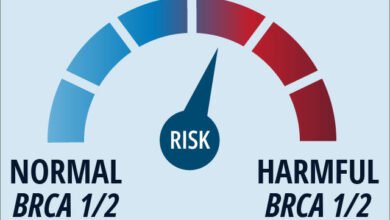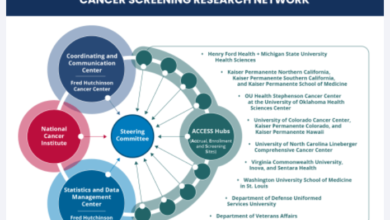Cancer Research UK – Science blog
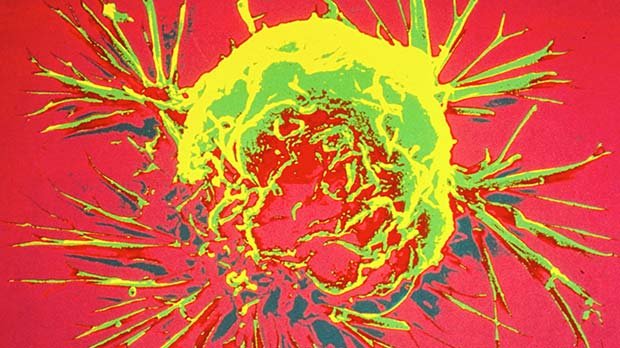
Breast cancer cells might use bioelectric signals to influence their behaviour. NIH / CC BY-NC 2.0
You’re electric.
Not in a charge via USB, keep away from water kind of way – but electric all the same. We all are. Electricity is a big part of how our bodies work. Our cells need to keep certain chemicals inside and push others out, which each one a voltage, like a tiny battery.
That gives our cells the power to do some incredible things. The ones in our hearts, brains and nervous systems use bioelectricity on their outer layers – in precise patterns of blinks, waves and buzzes – to flash signals and messages through the body. We think and feel in lightning storms – which makes sense, because thoughts and feelings come like lightning storms sometimes.
Dr Amanda Foust, a neuroscientist and engineer at Imperial College London, is one of the few people who knows how to catch that lightning. She thought she knew the types of cell it struck, too.
Then she got an unusual tip-off. On the advice of a colleague, she turned her cellular storm-chaser’s kit to look at the voltage, or electrical potential, on the outer layer (membrane) of breast cancer cells.
“We saw that it was fluctuating, which completely blew me away. I never expected that in cells that weren’t in the heart or the brain or other muscles.”
That’s because healthy cells in the rest of the body have a static membrane voltage. But this new study, which was led by Foust and Dr Chris Bakal from the Institute of Cancer Research, shows that breast cancer cells can change their voltage in predictable patterns. And that raises some very big questions.
How cancer cells use electricity
Right now, we don’t know what the patterns mean, but it looks like they’re happening for a reason. The team found that cancer cells were more likely to blink together than alone. At times, they even spotted “waves of flux” passing between them.
“One cell would blink, then another cell nearby would blink, then another, and so on and so forth,” says Bakal, one of our funded cancer researchers. “That really is a huge sign to me – it’s not proof, but it’s a huge sign that these cells are communicating with each other.”
In fact, Bakal thinks cancer cells could be using electrical signals as a type of language. And he doesn’t find that as shocking as you might expect. In his other research, he’s seen cancer cells change their size and shape to look more like brain cells.
Foust doesn’t want to go quite so far yet. She and Bakal have a friendly disagreement about what exactly their findings mean.
“I tend to hesitate about calling it a language,” Foust says. “There’s a lot of unanswered questions. Are these electrical fluctuations just the hum that the engine makes, or do they play a role in something that cancer does that makes it so bad?”
Either way, it’s significant. The noise an engine makes tells a good mechanic a lot about what it’s doing.
And we already know that electrical activity is linked to one of the central problems of cancer: its ability to spread through the body, or metastasise. That discovery was made by Imperial’s Professor Mustafa Djamgoz, the colleague and co-author who suggested Foust take a closer look at cancer cells.
Bioelectricity and cancer metastasis
In 1995, Djamgoz showed that prostate cancer cells could alter their baseline voltage open specific channels in their membranes.
These ‘voltage-gated’ channels aren’t normally found outside of the nervous system or muscles. They control how electrically charged particles called ions move in and out of cells, making them more ‘electrically excitable’ and changing how they behave.
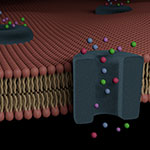
By opening and closing ion channels, cancer cells can change how they behave. ©TaePY15MU /Shutterstock.com
Djamgoz focused on one channel in particular: a sodium channel. Cancer cells open it to let in ions that make them more likely to metastasise. This ability to spread and form secondary tumours in other organs is the main cause of death from cancer. Closing the sodium channel on cancer cells could be a way to stop it happening.
Djamgoz and others are now trying to develop therapies to close that channel.
Early-stage research in animal models suggests it could be an effective treatment. In the US, researchers led by Professor Michael Levin, a bioelectricity expert at Tufts University, have reversed the development of tumours in some tadpoles by manipulating ion channels.
There’s other work highlighting the importance of ion channels, too. Last year, scientists at our Cambridge Institute revolutionised our understanding of metastasis by identifying a gene that controls one. When that gene, called NALCN, is ‘turned off’ in cells, they’re much more likely to spread through the body – whether they’re healthy or cancerous.
Even if they aren’t a language in themselves, Foust thinks the fast voltage fluctuations she and Bakal have found could be relevant here. They might be ways to modify other electrically sensitive signals in the cells, including certain ion channels.
Electric healing
Cancer is a disease of cell growth, and bioelectricity seems to play a big part in how bodies grow and heal. Maybe their connection shouldn’t be too much of a surprise.
Then again, almost everything scientists are discovering about bioelectricity is surprising.
One of the first things they found, back in the 1970s, was that injured skin cells generate an electric field. This ‘wound current’ attracts other cells that specialise in repairing damage.
From there, things get weird. It’s one thing to guide cells through the body, but it seems that bioelectricity can help certain animals grow new limbs.

Bioelectricity could help explain how salamanders regenerate lost limbs. ©2011 Scott Camazine. CC BY-SA 3.0
“There are hints that setting up bioelectric fields can give the body almost a template for regeneration,” says Bakal. “If you cut off part of an organism that can regenerate, like a salamander, it looks like the body sets up an electric field that guides the cells to move and start regrowing the limb. It’s like the field is a marker for where the cells should go and how they should develop.”
Strange things happen when that field gets disrupted. In 2017, Levin’s team cut the tails off some flatworms and altered the current at the site of the wound. Most of the worms grew a second head. They also found that the way tadpole embryos grow and take shape is controlled by electrical signals sent from their brains.
Levin’s studies are still a long way from humans, but, tellingly, the signals his team are investigating also control ion channels.
Cracking cancer cells
Foust and Bakal’s study, which we helped fund, has taken our understanding of bioelectricity in cancer further than ever.
Until recently, it was only possible to look at electrical activity in one cancer cell at a time. There was no way to spot high-speed changes they might use for signalling, either.
Now, though, Foust’s microscopes can track what’s happening across large groups of cells at once, and they can keep up with unimaginably fast fluctuations in voltage. Combined with Bakal’s machine learning tools, they have the potential to show us exactly how cancer cells use electricity.
“We really want to find out both the causes and the effects of the signalling,” says Bakal. Who’s right – is it or isn’t it a language?
“What’s the difference between a blink and a wave in terms of how the cell sees it and responds?” Bakal asks. “Are they words that cells use? Are there sentences of words that cells process to do something even more complicated?”
“We really need to see how the membrane potential fluctuations correlate with how cells grow, move and proliferate [increase in number],” agrees Foust. “And we need to push into more complex 3D models so we can be more relevant to what happens in people.”
Those questions are a little different, but they can only be answered together. Foust and Bakal have got so far because their team combines neuroscientists, cancer biologists, engineers and machine learning experts. “This is really one of these perfect situations where different fields come together and give us something we couldn’t have reached otherwise,” says Bakal.
What does this all mean for treating cancer?
The idea of cancer cells also working together, whispering back and forth under the rest of the body’s crackle, isn’t a comfortable one. It’s hard to accept that cancer could exploit the way we think, feel and act to achieve its own harmful ends. The idea can even seem like a contradiction: cancer is often called a disease of unchecked or uncontrolled cell growth.
“Everyone expects cancer to be this out-of-control growth, where all the cells are different,” says Bakal. “But I think it’s becoming clear that there’s quite a bit of order. Hell doesn’t just break loose: I think they’ve changed their control system, evolved their own control systems to be able to do what they do.
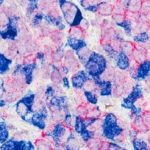
Breast cancer cells Credit: NCI
“Different parts of the tumour are signalling to each other, perhaps to coordinate growth. They’re setting up their own little communication networks to function together as a community.”
And that’s something doctors and scientists can work with. If cancer cells rely on communication, we can treat cancer by stopping its cells communicating.
“Disrupting the communication is only going to be beneficial,” explains Bakal. “It gives us hope for new treatment strategies.”
Think about it: what would things be like if we couldn’t communicate?
There wouldn’t be any of these words here, for a start, or any scientists teaming up to investigate cancer, but it gets much more fundamental than that. Would we be here at all without our ability to talk and share?
Imagine trying to build a house as part of a group that couldn’t plan or work together. Imagine the house you manage to build.
Then, since all of this is electric anyway, imagine it being hit by a lightning storm.
“It’s the same for any community,” says Bakal. “We’re much more vulnerable if you disrupt the communication between us.”
Tim
References
“Voltage Imaging Reveals the Dynamic Electrical Signatures of Human Breast Cancer Cells” by Peter Quicke, Yilin Sun, Mar Arias-Garcia, Melina Beykou, Corey D. Acker, Mustafa B. A. Djamgoz, Chris Bakal, and Amanda J. Foust. Published 11 November 2022 in Communications Biology.
This study was funded by the Integrated Biological Imaging Network, the Royal Academy of Engineering, the Biotechnology and Biology Research Council (BBRC, part of UKRI), Wellcome Trust, Engineering and Physical Sciences Research Council (EPSRC, part of UKRI), Cancer Research UK and Stand Up to Cancer UK.
Source link
#Cancer #Research #Science #blog

